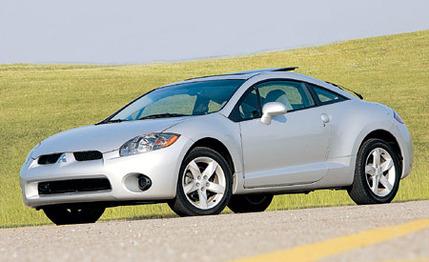
 Short Take Road Test
Short Take Road Test
Whatever the sport may be, for every major-league player, there are a half-dozen others toiling in the unglamorous obscurity of the minors. At a glance, they seem to possess the same style and athletic grace of the first-rank guys, but on closer scrutiny, their performance doesn't quite measure up.
The same is true in the world of affordable sports coupes. The hotter GT versions get the spotlight and the headlines, and the lesser editions quietly account for most of the sales. Which brings us to the Mitsubishi Eclipse GS. It lacks the power and moves of the GT, but it plays for a lot less money, and to the casual eye it's indistinguishable from its more potent teammate.
This last is obviously important, and it's equally obvious that Mitsu has stepped up its styling game. The new Eclipse discards the cerebral "geomechanical" strakes and angles of the gen-three car-a shape that could be considered sexy only by Stevie Wonder-for smooth, fluid lines that advance the design evolution of gen two as though gen three never happened. It's a shape anyone could call sexy, Stevie included. Remember, half of life is just showing up. The other half is looking good when you do.
The machinery sheltered by this seductive skin owes much to a sibling, the Galant sedan, including its platform and powertrains. The 3.8-liter V-6 that distinguishes the Eclipse GT delivers a considerably heftier punch than its sedan counterpart-263 horsepower versus 230-but the output of the 2.4-liter four used in the GS is all but identical: 162 horsepower (versus 160) and 162 pound-feet of torque (versus 157).
The Mitsu SOHC four-banger isn't quite as contemporary as some of its contemporaries. The twin-cam 16-valve fours in the Acura RSX, Chevy Cobalt SS, Hyundai Tiburon GS, Saturn Ion Red Line, and Scion tC are all-aluminum, whereas the Mitsubishi's block is still composed of good old cast iron, which contributes to the GS's portly performance at the scales: 3331 pounds. In contrast, the last RSX we tested, a Type-S ( C/D, September 2005), weighed in at 2843 pounds.
However, the top end of the Eclipse four is fully up to date, thanks to Mitsubishi's MIVEC, an acronym for "Mitsubishi Innovative Valve timing and lift Electronic Control," which is how you say VTEC if you happen to toil under the diamond-star banner. Paired with a five-speed manual transmission, the four-cylinder powers the Eclipse to 60 mph in 8.2 seconds. That is not thrill-ride territory, but adequate if haste isn't a major issue.
The same applies to this car's handling traits. The suspension tuning is a tad softer than the Eclipse GT's, with a slightly smaller (by 0.04 inch) rear anti-roll bar and a little less contact patch to handle cornering loads: 225/50R-17 Goodyear Eagle RS-A tires versus the optional 235/45R-18s on the GT. Still, if the GS rolls a little more than the GT in hard cornering, it sticks nearly as well, pulling 0.82 g on the skidpad versus 0.81 for the Eclipse GT we tested last July. And its braking performance-178 feet from 70 mph-is four feet better than the GT's, stacking up with the best in this class. Could the GT's additional 229 pounds have something to do with this? You bet.
Beyond all this, and the higher fuel-economy ratings that go with the four-cylinder engine, there is one distinct GS performance advantage: Torque steer, a problem brought on by the GT's greater power, is absent here.
The other GS advantage, of course, is at the bank. With a base price of $19,994, the GS undercuts the GT by $4300. That's far from the bottom of this market. You can strap on a Scion tC for as little as $16,715, and a Hyundai Tiburon GT with V-6 power starts at $18,594. But the Eclipse GS has a goodly array of comfort and convenience features baked into its base price, plus the allure of a shape that is arguably the segment's sexiest. Hard to put a value on that.